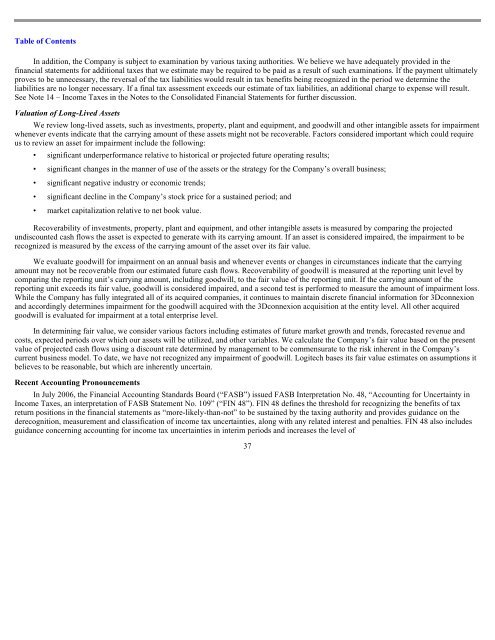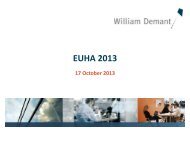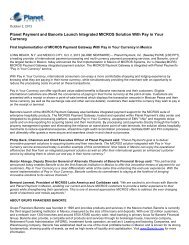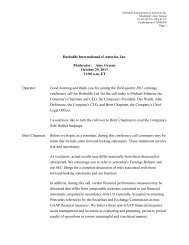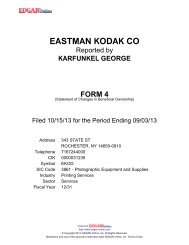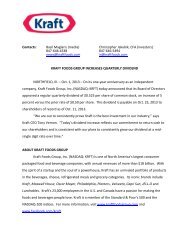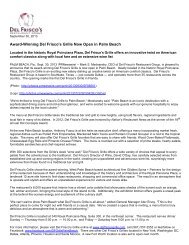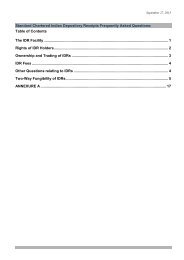LOGITECH INTERNATIONAL SA - Shareholder.com
LOGITECH INTERNATIONAL SA - Shareholder.com
LOGITECH INTERNATIONAL SA - Shareholder.com
Create successful ePaper yourself
Turn your PDF publications into a flip-book with our unique Google optimized e-Paper software.
Table of Contents<br />
In addition, the Company is subject to examination by various taxing authorities. We believe we have adequately provided in the<br />
financial statements for additional taxes that we estimate may be required to be paid as a result of such examinations. If the payment ultimately<br />
proves to be unnecessary, the reversal of the tax liabilities would result in tax benefits being recognized in the period we determine the<br />
liabilities are no longer necessary. If a final tax assessment exceeds our estimate of tax liabilities, an additional charge to expense will result.<br />
See Note 14 – In<strong>com</strong>e Taxes in the Notes to the Consolidated Financial Statements for further discussion.<br />
Valuation of Long-Lived Assets<br />
We review long-lived assets, such as investments, property, plant and equipment, and goodwill and other intangible assets for impairment<br />
whenever events indicate that the carrying amount of these assets might not be recoverable. Factors considered important which could require<br />
us to review an asset for impairment include the following:<br />
• significant underperformance relative to historical or projected future operating results;<br />
• significant changes in the manner of use of the assets or the strategy for the Company’s overall business;<br />
• significant negative industry or economic trends;<br />
• significant decline in the Company’s stock price for a sustained period; and<br />
• market capitalization relative to net book value.<br />
Recoverability of investments, property, plant and equipment, and other intangible assets is measured by <strong>com</strong>paring the projected<br />
undiscounted cash flows the asset is expected to generate with its carrying amount. If an asset is considered impaired, the impairment to be<br />
recognized is measured by the excess of the carrying amount of the asset over its fair value.<br />
We evaluate goodwill for impairment on an annual basis and whenever events or changes in circumstances indicate that the carrying<br />
amount may not be recoverable from our estimated future cash flows. Recoverability of goodwill is measured at the reporting unit level by<br />
<strong>com</strong>paring the reporting unit’s carrying amount, including goodwill, to the fair value of the reporting unit. If the carrying amount of the<br />
reporting unit exceeds its fair value, goodwill is considered impaired, and a second test is performed to measure the amount of impairment loss.<br />
While the Company has fully integrated all of its acquired <strong>com</strong>panies, it continues to maintain discrete financial information for 3Dconnexion<br />
and accordingly determines impairment for the goodwill acquired with the 3Dconnexion acquisition at the entity level. All other acquired<br />
goodwill is evaluated for impairment at a total enterprise level.<br />
In determining fair value, we consider various factors including estimates of future market growth and trends, forecasted revenue and<br />
costs, expected periods over which our assets will be utilized, and other variables. We calculate the Company’s fair value based on the present<br />
value of projected cash flows using a discount rate determined by management to be <strong>com</strong>mensurate to the risk inherent in the Company’s<br />
current business model. To date, we have not recognized any impairment of goodwill. Logitech bases its fair value estimates on assumptions it<br />
believes to be reasonable, but which are inherently uncertain.<br />
Recent Accounting Pronouncements<br />
In July 2006, the Financial Accounting Standards Board (“FASB”) issued FASB Interpretation No. 48, “Accounting for Uncertainty in<br />
In<strong>com</strong>e Taxes, an interpretation of FASB Statement No. 109” (“FIN 48”). FIN 48 defines the threshold for recognizing the benefits of tax<br />
return positions in the financial statements as “more-likely-than-not” to be sustained by the taxing authority and provides guidance on the<br />
derecognition, measurement and classification of in<strong>com</strong>e tax uncertainties, along with any related interest and penalties. FIN 48 also includes<br />
guidance concerning accounting for in<strong>com</strong>e tax uncertainties in interim periods and increases the level of<br />
37


